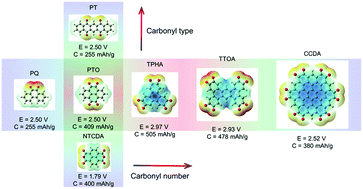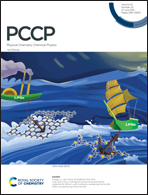Revealing practical specific capacity and carbonyl utilization of multi-carbonyl compounds for organic cathode materials†
Abstract
Organic carbonyl compounds are regarded as promising candidates for next-generation rechargeable batteries due to their low cost, environmentally benign nature, and high capacity. The carbonyl utilization is a key issue that limits the practical specific capacity of multi-carbonyl compounds. In this work, a combination of thermodynamic computation and electronic structure analysis is carried out to study the influence of carbonyl type and carbonyl number on the electrochemical performance of a series of multi-carbonyl compounds by using density functional theory (DFT) calculations. By comparing discharge profiles of six tetraone compounds with different carbonyl sites, it is demonstrated that pentacene-5,7,12,14-tetraone (PT) with para-dicarbonyl and pyrene-4,5,9,10-tetraone (PTO) with ortho-dicarbonyl undergo four-lithium transfer while the other four compounds with meta-dicarbonyl fragments show only two-lithium transfer during the discharge process. By further increasing the carbonyl number, the electrochemical performance of molecules with similar para-dicarbonyl sites to PT can not be strongly improved. Among all the studied multi-carbonyl compounds, triphenylene-2,3,6,7,10,11-hexaone (TPHA) and tribenzo[f,k,m]tetraphen-2,3,6,7,11,12,15,16-octaone (TTOA) with similar ortho-dicarbonyl sites to PTO exhibit the best electrochemical performance due to simultaneous high specific capacity and high discharge voltage. Our results offer evidence that conjugated multiple-carbonyl molecules with ortho-dicarbonyl sites are promising in developing high energy-density organic rechargeable batteries.



 Please wait while we load your content...
Please wait while we load your content...